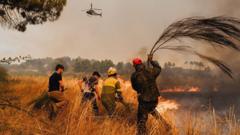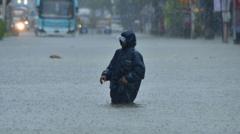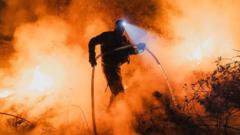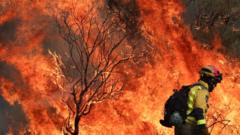Northern China braces for unprecedented wind speeds, damaging infrastructure and contributing to dust storms.
Record-Breaking Winds Batter Northern China, Prompting Emergency Warnings

Record-Breaking Winds Batter Northern China, Prompting Emergency Warnings
Beijing faces the strongest near-hurricane winds in 70 years, forcing residents to remain indoors and disrupting travel.
Beijing's 22 million residents were urged to stay indoors as powerful winds swept across northern China this past Saturday. The winds, which are forecasted to be the strongest April gusts in the capital city since 1951, began affecting the region on Friday, leading to the uprooting of trees, travel disruptions, and the onset of dust storms. According to the Chinese state media, gusts could reach speeds of 83 to 92 miles per hour, with temperatures plummeting as a result.
By Saturday morning, over 400 trees had been toppled in Beijing, and nearly 7,000 residents were evacuated due to the hazardous conditions. Dust storms not only swept through the capital but also affected regions across northern China. Yang Bobo, a finance postgraduate student at a local university, described the ferocious gale as “wailing like ghosts”. The strong winds even dislodged a glass door at her school, prompting her to stay indoors for her safety.
As reported on the social media platform Weibo, the winds rattled windows and caused damage to utility poles in central China's Henan Province. In response to the extreme weather, city authorities advised residents against nonessential travel, postponing scheduled soccer matches. Train and bus services were suspended, and authorities at Beijing's main international airport warned of potential flight cancellations. China Southern Airlines alone canceled 340 flights due to the inclement weather.
Meteorological forecasts indicated a drastic temperature drop from recent highs of 80 degrees Fahrenheit to a mere 57 degrees. This intense weather system wasn't confined to China; strong wind warnings were also issued in neighboring South Korea and Japan, extending the area of impact from the polar vortex situated over Mongolia, according to Woo Jin-gyu of the Korea Meteorological Administration.
By Saturday morning, over 400 trees had been toppled in Beijing, and nearly 7,000 residents were evacuated due to the hazardous conditions. Dust storms not only swept through the capital but also affected regions across northern China. Yang Bobo, a finance postgraduate student at a local university, described the ferocious gale as “wailing like ghosts”. The strong winds even dislodged a glass door at her school, prompting her to stay indoors for her safety.
As reported on the social media platform Weibo, the winds rattled windows and caused damage to utility poles in central China's Henan Province. In response to the extreme weather, city authorities advised residents against nonessential travel, postponing scheduled soccer matches. Train and bus services were suspended, and authorities at Beijing's main international airport warned of potential flight cancellations. China Southern Airlines alone canceled 340 flights due to the inclement weather.
Meteorological forecasts indicated a drastic temperature drop from recent highs of 80 degrees Fahrenheit to a mere 57 degrees. This intense weather system wasn't confined to China; strong wind warnings were also issued in neighboring South Korea and Japan, extending the area of impact from the polar vortex situated over Mongolia, according to Woo Jin-gyu of the Korea Meteorological Administration.


















